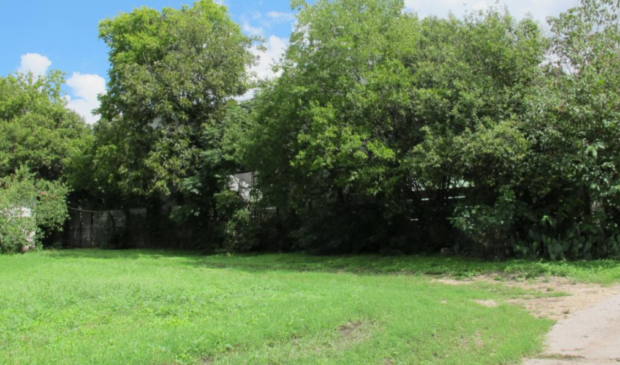Council signals support for row houses over staff objection
Friday, March 8, 2019 by
Jack Craver City Council signaled support for a project that will bring five row houses to the Blackland neighborhood in East Austin, over the objections of city staff and a vocal contingent of neighborhood residents.
Council approved “on first reading” rezoning the property at 2107 Alamo St. from single-family (SF-3) to multifamily, allowing the developer to replace the existing duplex with five units, one of which will be dedicated to the Blackland Community Development Corporation to be sold or leased to a family at 60 percent of the area median income, or $51,600 for a family of four.
Council must approve the rezoning on second and third readings before it is official.
The proposed rezoning was not recommended by the Planning and Zoning Department, which cited the Upper Boggy Creek Neighborhood Plan’s stated goal of preserving the single-family character of the interior of the neighborhood. However, the project was narrowly endorsed by the Blackland Neighborhood Association and overwhelmingly endorsed by the Upper Boggy Creek Neighborhood Plan Contact Team.
The rezoning was recommended 8-3 by the Planning Commission last week, with several supportive commissioners expressing disappointment with staff’s focus on neighborhood character over other priorities, notably affordable housing and transit access.
The tenor at Council was similar on Thursday, with Council members applauding a project that will bring a permanently affordable unit to an area that is now heavily gentrified.
Council Member Natasha Harper-Madison, who represents the area, said that the proposed two-bedroom homes are the kind of “missing middle housing” that the city needs more of to address its housing shortage and prevent sprawl.
“You can literally see the bus stops from this property,” she said, referring to the high-frequency Route 20, which goes downtown. “It’s a complete community, which is our aim, or so I thought.”
Harper-Madison added that “not everybody will be happy when neighborhoods change,” but that the city’s goal should be to guide change in a way that is most beneficial.
As she did at Planning Commission, Lottie Dailey, who until recently was president of the Blackland Neighborhood Association, urged for approval of the project and suggested opponents were worried that an income-restricted unit would harm their property value.
Austin Dennis, another neighborhood resident, stressed that while the project’s four market-rate units would not be affordable to low-income families, they would likely be cheaper than the larger single-family home or duplex that would be built under current zoning.
The three residents who spoke against the project strongly rejected that argument, emphasizing their past support for affordable housing in the area. Their problem is with the density in a single-family neighborhood.
“What this does is start to bring in multifamily next to single-family homes,” said Catherine Tucek, a 23-year resident of the area. “Are single-family homes a sin now? Is it wrong to want to have a house with a yard?”
Council Member Alison Alter said she felt conflicted about the project, but cited the support from the neighborhood association in her decision to cast a yea vote. Council Member Leslie Pool was also conflicted and said she would continue to ponder the case before it comes back for second and third reading.
Pool said she believed there was “broad consensus” that the city needs more housing, particularly “housing options that are attractive and attainable for less affluent families.” However, she said the “piecemeal” rezoning process was “not ideal,” and that she hoped Council could develop a more comprehensive approach to addressing the city’s housing needs by revising the land development code.
The only dissenting vote came from Council Member Kathie Tovo, who said that the developer would likely be able to achieve three units on the property by subdividing the property under current zoning. She queried Glen Coleman, an agent for the property owner, about how many bedrooms each unit would have and said she would prefer the affordable unit have three bedrooms instead of two.
Coleman said it was unlikely that they could get three bedrooms into one unit.
Tovo also pushed back on an earlier description of the four market-rate units as “affordable.”
“I think the resulting cost of the housing will be much more expensive” than the existing housing, she said.
In an ostensible response to Tovo’s comments about bedrooms, Mayor Pro Tem Delia Garza said she wanted to see city leaders think differently about how they define “family-friendly housing,” recalling a recent conversation with her father about the small home he grew up in with his family of 10.
In response to the comment from Tucek, Garza said she did not believe single-family housing was a sin, but that it would be a sin for the city not to recognize “that some families can afford yards and some cannot.”
Council Member Pio Renteria similarly recalled his own upbringing in East Austin, in a two-room house with 10 kids. Conversely, he highlighted a recent article in The New York Times about the declining birth rate among Latinos. Families are getting smaller and don’t want as many bedrooms, he said.
The only way to keep people of modest means in the central neighborhoods that he grew up in, he said, is to build more and different kinds of housing.
Photo courtesy of the city of Austin.
The Austin Monitor’s work is made possible by donations from the community. Though our reporting covers donors from time to time, we are careful to keep business and editorial efforts separate while maintaining transparency. A complete list of donors is available here, and our code of ethics is explained here.
You're a community leader
And we’re honored you look to us for serious, in-depth news. You know a strong community needs local and dedicated watchdog reporting. We’re here for you and that won’t change. Now will you take the powerful next step and support our nonprofit news organization?




